Wednesday, June 27, 2012
Cycling Tour of Taiwan Video
Here is a great little video of a couple of guys on a Round-Taiwan tour. They seem to have picked a pretty good route and taken the time to capture it on video. The sped-up effect is one of my personal favorites.
Monday, June 25, 2012
Taiwan's Soft Diplomacy: Cycling The World To Make Space For Taiwan

A pair of child's overalls from 1978 with an ROC flag and the slogan, "I Love China/Chinese". This provides an excellent example of how these Chinese Nationalist symbols were used to reinforce KMT party ideology in children. The symbolism was a performative means through which Taiwanese located on the periphery could attempt to satisfy their ethnic burden and benefit from drawing closer to state power. The ROC flag is still a very important symbol in every school.
The CNA via Taiwan Focus brings us an interesting article on a Taiwanese cyclist who will embark on an extended bike tour to highlight Taiwan's difficulty in negotiating an ambiguous national identity.
Teddy Liao, who prefers to be known as "Taiwan Floatman," will wear a T-shirt printed with the Republic of China's national flag and perform "human flag" maneuvers in which he makes his body parallel to the ground while holding a pole at famous scenic sites in various countries.
Liao, 28, who has sold his bike shop in central Taiwan's Taichung city, told CNA that he's motivated to quit his job and travel in this unusual way because he is patriotic and is concerned about Taiwan's unique international status.
The island of 23 million people is not recognized as a country by the United Nations because China considers it a province to be reunified one day.
As a result of Beijing's objections to Taiwan being treated as a country, Taiwan is often barred from participating in international organizations that require statehood or using its official name -- theRepublic of China -- at international events. The ROC moved its seat to Taiwan in 1949 after losing a civil war to the Chinese communist party.
Despite the warming ties between Taiwan and China, Taiwan is still not allowed to show its flag at international sports events, and thus many patriotic Taiwanese people or athletes make a point of showing Taiwan's flag in the audience sections or on the stage of sports competitions or other events.
What may be the most interesting aspect of this article is how Mr. Liao's trip not only accurately expresses the level of confusion and insecurity the current national policy of demurring ambiguity creates among its citizens, but also in how Taiwan's status as an unresolved post-coloniality has resulted in a confusing juxtaposition and reconfiguring of national identities and symbolism.
The debate over Taiwan's representation is not only being waged between the People's Republic of China (PRC/China) and Taiwan (Republic of China/ROC), there is also vigorous debate within Taiwan over the state of the nation.
Form Taiwan's earliest contact with the ROC, the relationship was defined as one between the centrality of the ROC state apparatus and the Taiwanese periphery. To gain access to the state's monopoly on power, Taiwanese were expected to move closer to the state center by adopting the state ideology of Tridemism, also known as Sunism after the writing of the Chinese ethnic nationalist writer, Sun Yat-sen.
Tridemism is based on the principles of Nationalism/Populism/Patriotism, Democracy, and Public Welfare. Sun Yat-sen believed the Chinese people were racially superior to the other peoples of Asia and, only through these principles, could rise up and become the masters of the "Yellow Race".
Sun's ideals were brought to Taiwan by the Chinese Nationalist Party (KMT) following WWII, which operated as a mirror to the Japanese colonial government it had replaced. The symbols of patriotism and nationalism were regular deployed to array out the nationalization program with the aim of transforming the Taiwanese people into Chinese.
This process put an incredible burden on Taiwanese to adopt idealized modes of behavior to satisfy the KMT state's requirements of patriotism, while the KMT maintained a gap between the civilized center and its degraded peripheral peoples (Taiwanese).
The ROC flag has remained a confusing and controversial symbol of Taiwan as it is based upon the KMT party flag, brought to Taiwan from China in 1945. After 40 years as a single party authoritarian state, Taiwan's transformation to a democracy failed to transform many of the former symbols of the pre-democratic regime and its failed neocolonial, China centered programs.
In the article above Mr. Liao expresses his desire to display his patriotism in the face of China's belligerence by displaying the national flag-- a flag that is often suppressed by Chinese efforts and also by the complicit acts of the ROC's own representatives.
It is not clear if Mr. Liao is a strong supporter of the constitutional ROC, the Chinese Nationalist state that still maintains a China-centered outlook, or if he has come to associate the old symbols of Chinese nationalism with the modern, democratic experience of Taiwan.
It Taiwan, it is commonly recognized that the ROC flag is not a neutral representation of the nation, but tightly associated with the KMT; a party which still officially seeks to realize its pipe dream of seeing Taiwan as a part of some "Chinese" entity. This would make Mr. Liao's efforts seem almost counter productive.
Many Taiwanese who support a formal declaration of independence steer clear of the old symbolism that is tied to the type of ethnocentrism that was used so effectively in maintaining the social cleavage between those who identified closely with the KMT state (and were the beneficiaries of their close relationship) , and those who did not.
As the majority of Taiwanese reject any type of Chinese identity in recognition of the realities of Taiwan as their center, the deployment of old symbols imbued with new meanings will likely continue and become more common as Taiwanese inch toward a "Taiwan consensus"driven from the bottom up. For many Taiwanese, there seems to be a type of dissonance between the Chinese centered history and experience of the ROC and the Taiwanese historo-political experience, as if the history of the ROC in China has been imported wholesale, reconfigured, and re-imagined as if it had happened in Taiwan.
What Mr. Liao may represent with his bike ride, is the possibility that a Taiwan centered nationalism has supplanted the China-centered model to become the predominant grammar for discussing the national expectations and aspirations of the Taiwanese. This bike project also betrays how the KMT and PRC policies of containment deployed against Taiwanese nationalism have produced the opposite of the desired effect.

Sunday, June 24, 2012
Around Liyu Reservoir (Route 52-3): Back To The Drawing Board

The View From The Top
A few months ago I could see the riding forecast and it looked poor. Our daughter was born in December and I took about a month to let my legs recover. Then my mother arrived for two weeks to see the baby. Just as I started to come back from about three weeks off I got sick, and then the weather went bad... and then I had a ride or two.... and then the weather went bad... and then my dad arrived for two weeks... and then the weather went bad... and then I got sick... and then the weather went bad... and then I did the Northern Cross Island Highway... and then the the weather went bad... and then a typhoon swept through Taiwan... and before I knew it, I was a couple months out of shape.

Crossing Into Dongshih
The weather this past weekend looked excellent for riding and I wasn't going to miss an opportunity to throw a leg over the top tube and start clawing my way back into shape.
I worked out an plan with Dom A. with the understanding that I would be using the ride as an easy warm-up to begin my training to get back to my former level of fitness; a level of fitness that once allowed me to chew up climbs and distance with relative ease.

Fight
Dom seemed to have other plans. He delighted in showing off his superior fitness and form as I struggled to find any form... of my previous...form.
I was sapped from the get-go. Dom was riding circles around me. Ouch!
Aside from the obvious lack of exercise, I hadn't really had much for dinner and my last serious ride occurred before the heat and humidity of summer had fully taken hold. Those conditions combined with a hilly route and a return headwind all converged on the day in a perfect storm of ego popping cycling madness.
Dom seemed to relish the opportunity to launch up ahead at will and completely disappear into the horizon. I quit trying to play catch-up and just tried to play "turn the pedals".

Typhoon Damage
Dom was feeling so much better, that he overshot the turn to the Route 52-3 (Xinli Agricultural Rd.)
The road was in rough shape after the typhoon, and was littered with all sorts of mud and debris for some technical riding. I didn't mind the fact that it kept the pace to something I could manage.

The road dips and curves along the northern edge of the Liyu Reservoir in a pleasant mix of short climbs, easy flats and a couple good dives through some picturesque orchards.

Aside from the typhoon slurry that was spread all over the tarmac, the road is pretty smooth... until is reaches a steep gradient that starts to look like someone's insanely steep private driveway. The road is rough and in desperate need of local construction funds. At times my rear wheel spun out on some type of road hazard or another.

Then things got really nasty.
The entire climb pitches up at over 20% and on a couple of occasions my front wheel lost contact with the ground.

Steepness
I dug in with a full tank of Everything I Had Left and chugged to the top.
The drop down the other side took concentration and careful attention to a good line. It seemed that each corner had become a slippery mud bog, more for the likes of a 4x4 or a swamp buggy. To take one of those corners with anything less than a straight line would have spelled a crash in an instant.
Despite the technical challenges, much of the road is a thrilling ride of undulating blacktop along forested ridge lines, above deep gullies, through low tunnels of uncut yellow bamboo.
Being forced to slow down forces you to take in the stunning spectacle that otherwise would be missed.

The road ends at the foot of the Liyu dam. As we rolled out onto the flats, I could feel my inner quads beginning to cramp. Each pedal stroke aroused the synapses into prompting another round of acute cramping.
Dom just rolled away out of sight into the headwind and there was little I could do to catch up. I finally waved him home and plodded along in agony as I fought cramps and a very stiff headwind all the way back into Taichung.


Not Only Is Dom's Patience Wearing Thin
By the time I threw my mud caked bike into the elevator of my apartment, I was still horribly cramping and just completely destroyed. I had nothing left except the notion that this was just the beginning of my campaign to get back into top form.... The first day of my comeback. Now I just need to remember to keep it purposeful and methodical to avoid any stupid injuries.

Maybe I'd Be Faster On This?
Also:
Check out Michael Turton's great ride over Yangming Shan.
Labels:
Liyu Reservoir,
Miaoli Route 52-3,
Ride Near Taichung,
Sanyi
Wednesday, June 20, 2012
Taiwan Represents At RAAM
I hope Taiwanese will come out to recognize Fu Sheng-chieh, the Taiwanese rider who made his first attempt at the Race Across America (RAAM). The RAAM is a brutal weeklong slog from Oceanside, California to Annapolis Maryland.
Fu has repeatedly used this opportunity to highlight Taiwan. Upon leaving for California, Fu wore an iconic T-shirt which read, "I am a Taiwanese".
Although Fu has only garnered a DNF in his first attempt, there is no reason he could not become the next Jure Robic.
Well done!
The Big Lie: Sun Moon Lake Cycling and Other Links

If you repeat a lie...
Taiwan Today had a recent article detailing the Merida cycling event at Sun Moon Lake. I made the observation that this event seemed suspiciously linked to a CNN-GO article and the Taiwan Tourism Bureau's desire to promote it. The Taiwan Today article actually and suspiciously mirrors and even quotes the CNN article's most erroneous statements, which I devoured in an earlier post HERE.
Sun Moon Lake, a natural alpine lake located in central Taiwan’s Nantou County, is surrounded by high forest mountains with stunning landscapes. The lake—named because its eastern part is round like the sun and its western part is narrow and long like a crescent moon—has been voted year after year by local and foreign visitors, including those from mainland China, as one of Taiwan’s must-see tourist spots.
Statistics from the Sun Moon Lake National Scenic Area Administration show that the number of visitors skyrocketed from 2.6 million in 2009 to 6.3 million in 2010, after the launch of a cable car service Dec. 28, 2009. The service became an instant hit as it offers a bird’s-eye view of the lake’s beauty in a relaxing 1.87-kilometer ride between the lake and the nearby Formosan Aboriginal Culture Village.
In 2011, the number of visitors declined slightly to 5.3 million. But the administrative office is confident that its efforts over the past few years in building a round-the-lake bikeway will soon spark another tourism boom, as hundreds and thousands of bicycle enthusiasts from around the world come flocking to the lake to indulge their passion for bicycling and soak in the beautiful local scenery.The TT Article begins to look more like an attempt by Tourism Bureau underlings to toady up to their superiors.
-----------------------------------------------
Also:
Bike Radar has an interesting piece that briefly mentions Taiwan. Sadly, the writer buys into the tired old Cold War tropes perpetuated by competing groups of Chinese nationalists in the CCP and the Kuomintang (KMT).
On a clear day you can see Taiwan from the coast. China and Taiwan are inextricably linked and their differences not so old as to be forgotten. Xiamen has a huge sign facing across the water that says ‘Two countries, one system’, essentially a declaration of friendship. Taiwan also has a sign, visible from Xiamen with binoculars, which says ‘Two countries, two systems’. Direct flights between the two places only began in the last two years, and there are many big military bases in the hills around Xiamen. Despite that, China and Taiwan are trade partners on a massive scale.This is notion is purely the invention of the writer's own China fantasy. From Xiamen you might be able to see the island of Jinmen (Kinmen), which is under the administration of the Republic of China; the official name of the state governing Taiwan. Still, it is NOT Taiwan. This is a oft repeated misconception employed to create the illusion of closer geographic proximity and, in the hopes of Chinese nationalists, possibly closer political proximity. This same strategy was used by Japan's colonial government on Taiwan, which published maps of Taiwan to include Mt. Fuji and the Home Islands resting just on the northern horizon.
Moreover, the idea that Taiwan and China are "inexorably linked" is a simple construct that stands as firm as the claim that Taiwan is inexorably linked to Japan, The United States, The Netherlands, the Balkans, the Azores or any other location. It all depends on subjectivities and how you wish to politicize them.
The repetition of these flimsy ideas are maddening. I wish it would stop.
And:
- Mark Caltonhill has written a wonderfully detailed piece on cycling the Rift Valley. If you are considering biking Taiwan's lovely East Coast, give this a read.
- Here are Dom's pictures from our trip across the Northern Cross Island Highway.
Monday, June 11, 2012
I Am Wet For Taiwan's Northern Cross Island Highway
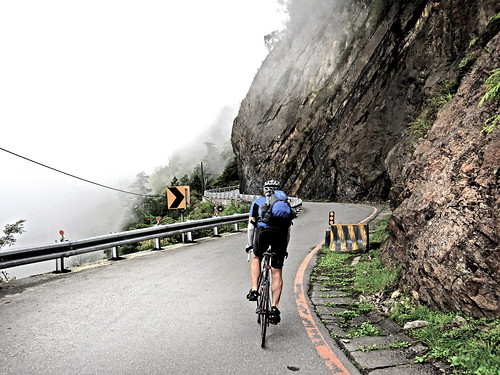
A couple times every year, Michael will organize a crossing of Taiwan's Central Mountain Range via the magnificent Highway 7. I have had to pass every time... until now. I can finally understand why this route is such a favorite.

We started our trip in Tucheng, at the Yongning station. The group consisted of Michael, Jeff, Dom and Myself. Along the way we were joined by Patrick, a loyal TiC reader who was eager to test out his new bike that is made for just about every type of riding Taiwan has to offer. One of the great things about Michael's Northern Cross Island Highway (NCIH) rides is the mix of people. You never know who will show up as it is an open invitation for just about anyone, and we were pleased to have Patrick join the fun.
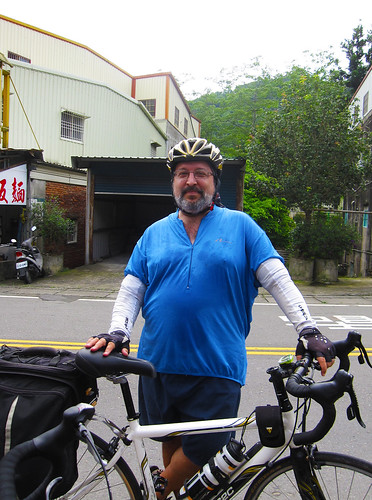
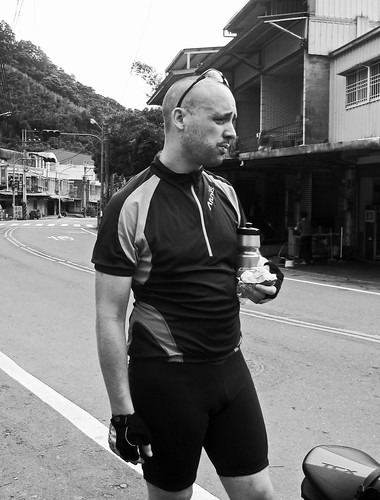
The heat and humidity had passed bearable long before we started climbing out of Sanxia. The best anyone could do was to deep moving in the vain hope of generating some airflow over the body. To make matters worse, I had left my water bottles at home and had to stuff a couple plastic bottles of H2O on my backpack. If I wanted a drink I would have to stop.

The scenery is lush and in about every shade of green. The hillsides below Little Wulai are now covered in plumes of bamboo.
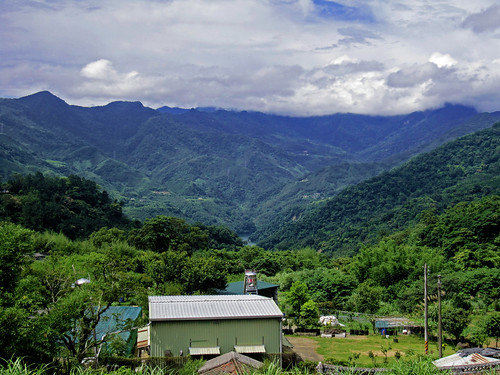
We fought through weekend traffic out to the less visited areas.
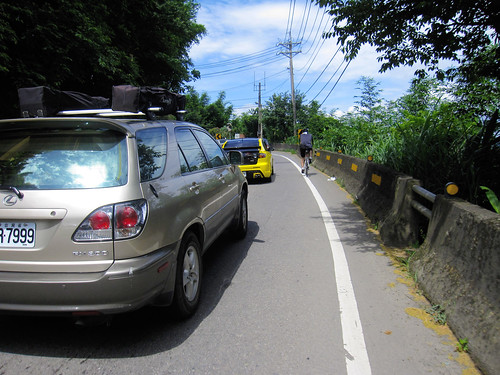
We stopped in Little Wulai for a bite to eat before making the transition from the foothills to mountains.
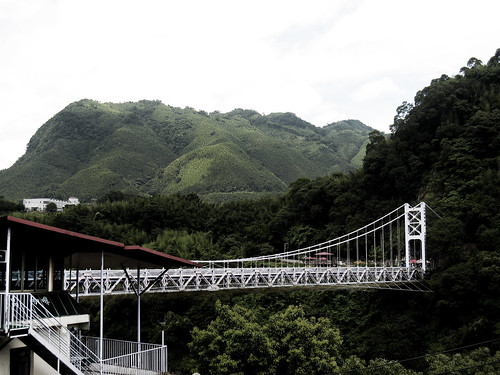
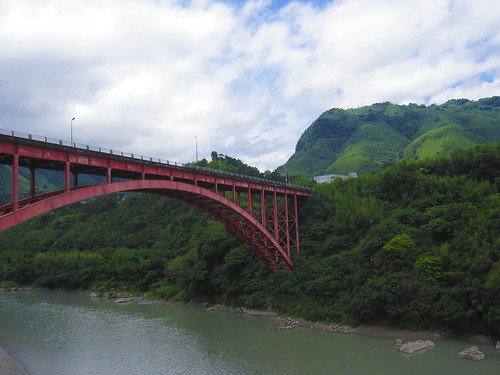
The road soon narrowed and we slithered our way along every contour of each hidden river valley.
In mountaineering, new routes or technical innovations are often named after the first to claim them. Although the NCIH is not new, it might very well be named the Turton Route. Michael has taken so many groups over that stretch of road he has become a fixture among the locals.
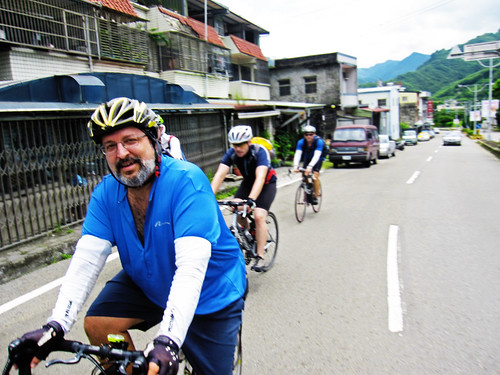

His connections were excellent in securing icy mango slushees for each rider at a particular rest stop.
We all pushed higher and higher. The imminent rain had held off all day. I was hoping we could all make it to Bailing dry. My hopes were dashed when large splatters of rain started coating the steaming tarmac.
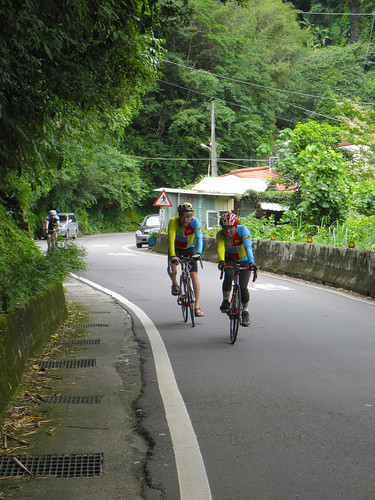
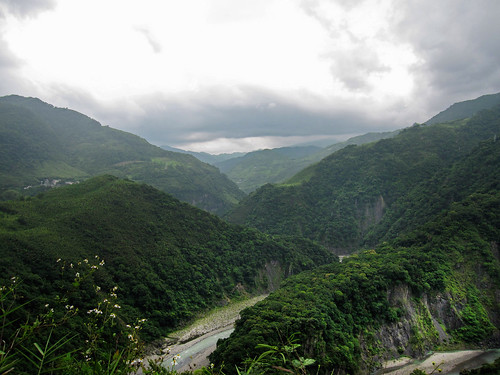
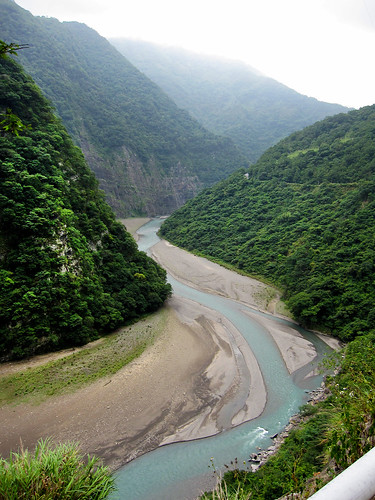
It was about at that point I turned things up a notch and hammered ahead toward Bailing.
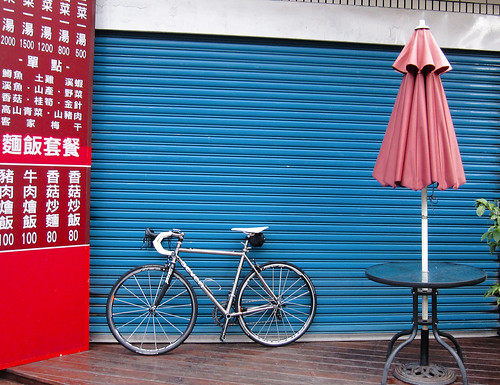
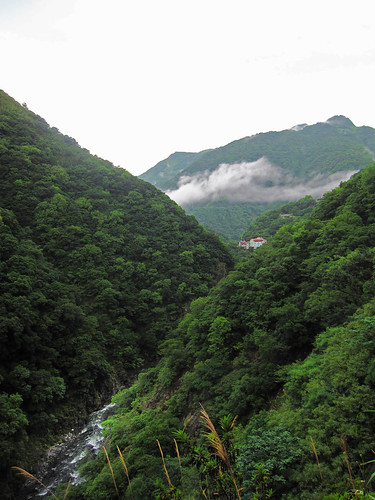
By the time our soggy group had all managed to drain the puddles from our shoes, it was exactly beer o'clock.
The place we were staying at billed itself as a "Bicycle Hostel". The only indication aside from the sign that this place catered to cyclists, was the space on the first floor that was made available to rest our bikes.
Later that evening we managed to find a nice meal with some fresh rice to fuel the climbs of the second day.
The entire neighborhood was awakened by an earthquaked measuring 6.5 on the Richter Scale, located about 70km off of Iilan. Seeing as the mountain hadn't buried us under 40 meters of clay, I went on trying to catch my beauty sleep.
Bright and early the next morning we were back on the bikes.
I hadn't been riding in about 4 or 5 weeks and I was feeling it in my tender bits. It takes a little time to get used to the saddle again.
Just up the road I turned around the catch a glimpse of Bailing before we stopped for "breakfast" on the bridge below La La Shan resort.
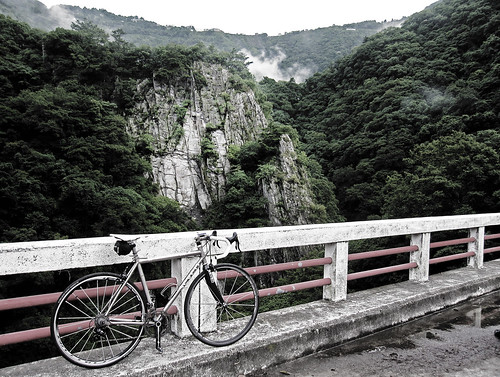
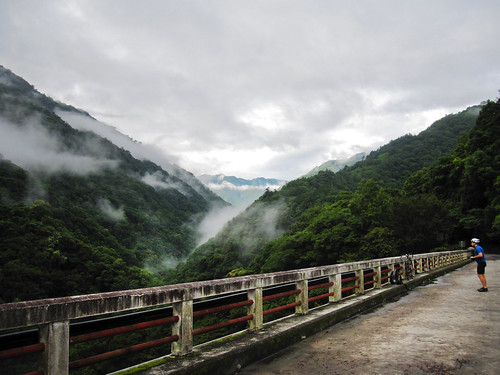
The weather was clear and it looked promising for a good day of riding.
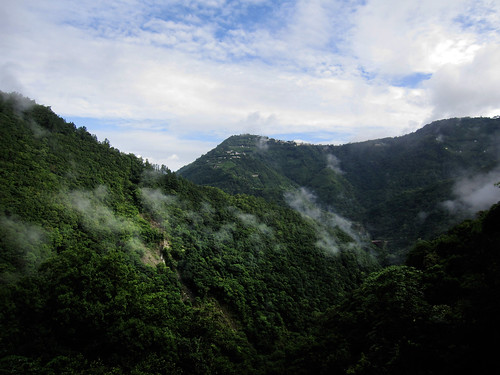
The road pitches upward for about 10km and it really saps the life out of you because it never feels very steep.

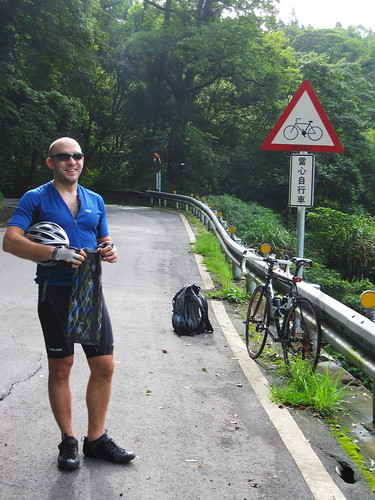
I was suffering a little dehydration as well from a dose of Benadryl I had taken the night before.
For a lot of this section Dom and I rode as the "escapees".

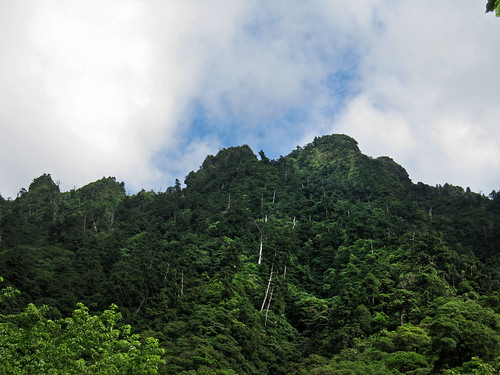
By the time we arrived at Mingchih, we were again met by the NTU eMBA group. They keeps claiming to have ridden the entire way, they also claimed to have taken off later than we did, but at no point did they ever pass us. Several support vehicles loaded with bikes lurking nearby seemed to hint at their cycling strategy.
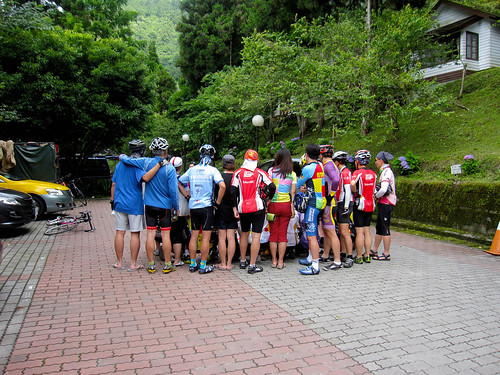
After a refill on fluids, we were again darting through the coolness of the shady cedars.

I had been expecting more of a climb, but before I knew it we were skimming along the rocky cliffsides high above the Iilan plain.
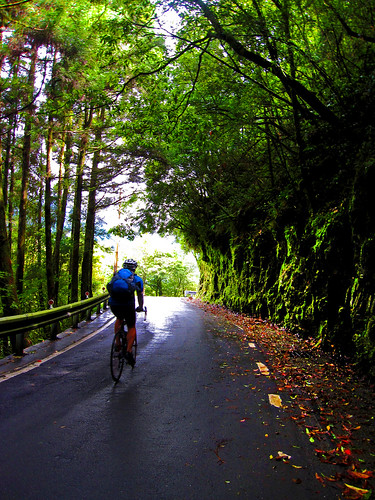
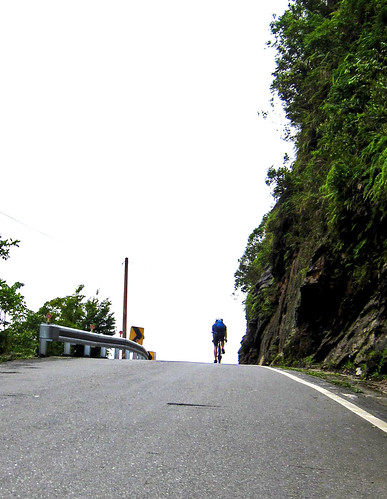
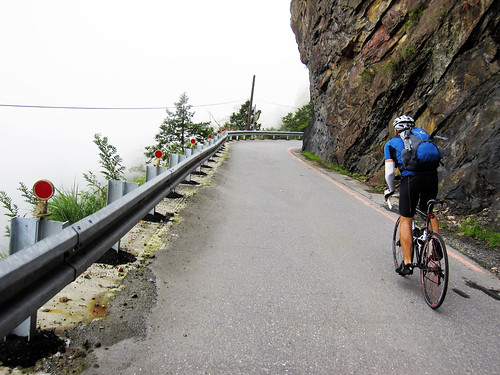
The scene called for the Guns of Navarone theme.
After some heroics in passing some stragglers from the eMBA group we hit the foggy descent.
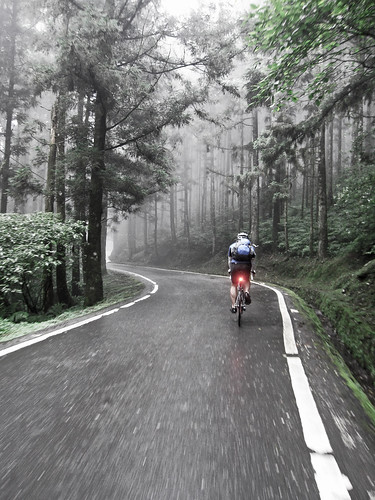
I don't remember much about the descent other than that I was focused in "the zone". With sloppy conditions and a road full of unsure cyclists, I pushed clear of the hazards and rode at a comfortable fast pace toward the bottom.
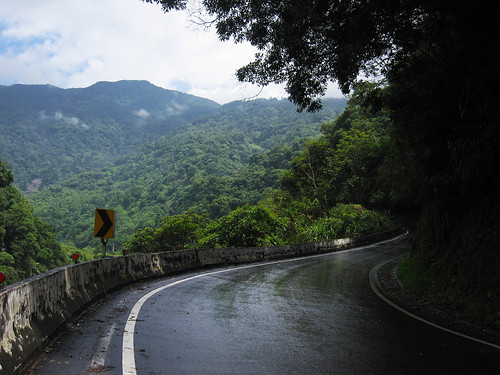
I felt plenty of tack in the tires, so I kept the speed up to stay ahead of the BMW that had been following me earlier, but failed to pass me when I gave him the chance. It was just an incredible descent until a roadblock where a landslide made it impossible for two cars to pass.
Just as I reached the bottom of the mountain, a heavy rain began to fall. We took shelter under the nearest tree, but it was of little use.
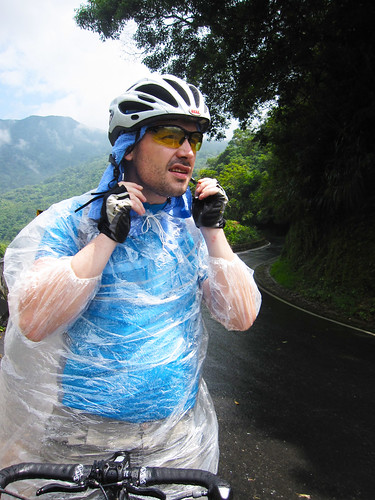
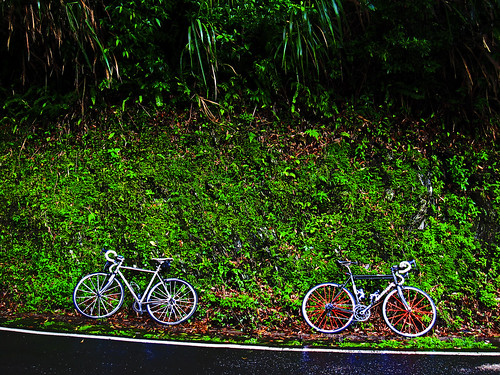
Eventually we all made it to a restaurant where we hoped to wait out the rain. The rain never really let up and we were soon at the mercy of the elements. I decided to Time Trial it back to Iilan and was surprised when the rain let up after about 10 minutes. It drizzled a little while later, but nothing serious. I realized I had only been rained on for about a half-hour during the entire trip. It was enough to get soaked, but not too bad.
In Iilan Dom and I had coffee and waited for the rest of the bunch. Soon everyone was going their separate ways home.

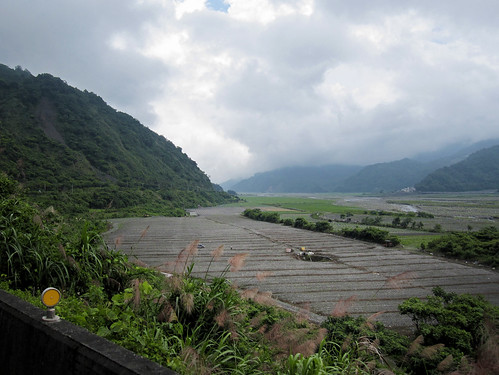
It was an excellent trip. The weather was there to add character.
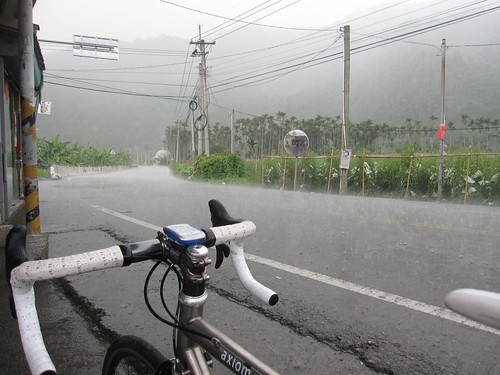
This is definitely worth doing again... and again.
Labels:
Baling,
Highway 7,
Iilan,
Mingchih,
Northern Cross Island Highway
Subscribe to:
Posts (Atom)
